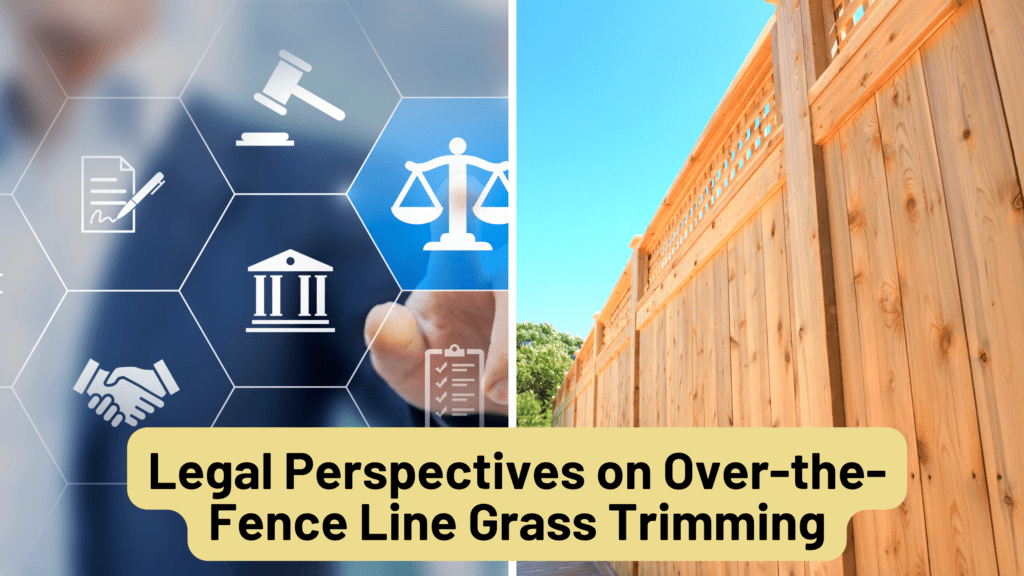If you own property, you’ve probably wondered about property lines and who’s responsible for fence maintenance. Well, today we’re diving into this topic to shed some light on the subject.
Understanding property lines and fence line responsibilities can help you avoid disputes and maintain a harmonious neighborhood. So, let’s jump right in!
Understanding Property Lines
If you own property, you’ve probably heard of the term ‘property lines.’ But what exactly does that mean? Let’s break it down.
What’s a Property Line Anyway?
Imagine a property line as an invisible fence around your land. It’s where your place ends and your neighbor’s starts.
It’s critical because it tells you who owns what and can help solve any disputes about land use or upkeep.
How are Property Lines Set?
When a chunk of land is first divided and sold, a property line is drawn. A surveyor comes in, measures everything out, and marks the borders of each plot.
These details are then put in a document called a ‘plat‘ which is like a map of the land divisions.
Of course, these lines can change over time, maybe due to legal agreements, natural events like rivers changing course, or other reasons.
But any change should be recorded legally to avoid a headache later.
Digging up Your Property Lines
Knowing your property lines is key. You wouldn’t want to accidentally build on your neighbor’s land, right? Here’s how you find them:
Check Out Your House Deed
Your house deed is a good place to start. It should have a legal description of your property, including the boundaries.
Look at the Plat Map
If your house deed doesn’t clear things up, you can get the plat map for your area. Your county recorder’s office or local city hall should have it.
Call in a Pro
Still not clear? Then it might be time to hire a professional land surveyor. They’ll do a thorough survey and give you a detailed map of your property lines.
Go Digital
Some places have online resources with GIS maps that show property lines.
Remember, knowing your property lines isn’t just about avoiding land disputes. It’s part of being a responsible property owner.
Keep in mind that rules can vary, so for the most accurate information, check with local authorities or a legal advisor.
Fence Line Responsibilities

Sure, we’ve talked about property lines, but what about fences? They mark your territory, offer privacy and security, and even add a little curb appeal.
But fence lines can also be a hot topic between neighbors, especially if it’s a shared fence.
Fences: More Than Just Wood and Nails
So what’s a fence line anyway? It’s where your fence stands or could potentially stand, marking the boundary of your property.
Fences aren’t just boundary markers, they also offer privacy, keep your pets or kiddos safe, and boost your home’s looks.
Keeping your fence line tidy isn’t just about good looks, it’s about respecting boundaries, staying friends with your neighbors, and following local rules.
Who’s Got to Fix the Fence?
Generally, if the fence is on your property, it’s your job to maintain it. If the fence is smack on the property line, it’s usually called a “boundary fence.”
For these, many places have laws that say neighbors should share the upkeep costs and work.
But don’t make any assumptions. Check your property deed or chat with a surveyor to confirm where the fence sits in relation to the property line.
If it’s all on your land, even by just a smidge, you might have to handle all the upkeep.
What’s the Local Scoop and HOA Say?
Fence upkeep can change a lot based on local rules. Some towns or counties have specific rules about who does what for fence maintenance.
They might dictate everything from fence materials and height to who pays for repairs.
And if you’re in a homeowners association (HOA), they might have their own rules. They could specify the type of fence you can have, its color, how tall it can be, and how to keep it looking good.
So figuring out fence responsibilities is a blend of knowing legal boundaries, local and HOA rules, and having open chats with your neighbors.
In the next sections, we’ll look at handling disputes and keeping things cool when it comes to fence line upkeep, especially dealing with grass trimming along the fence line.
Grass Over the Fence Line Scenarios
Ah, the classic grass and vegetation dilemma along the fence line. It’s a common issue that can stir up some tension between neighbors.
But fear not! Let’s explore some typical scenarios and potential ways to handle them.
Scenario 1: Overhanging Grass from a Neighbor’s Yard
Picture this: your neighbor’s grass and plants are making their way over or through the fence, invading your space. Not cool.
Resolution Options:
Friendly Neighborly Discussion
Try having a friendly chat with your neighbor about the issue. They might not even realize it’s causing a problem.
This approach can maintain or even strengthen your neighborly bond. Just remember, it relies on your neighbor’s goodwill and understanding.
Check Local Ordinances or HOA Rules
If the friendly approach doesn’t work or isn’t possible, take a look at your local regulations or HOA rules. Some places have specific guidelines for overhanging vegetation.
If that’s the case, you can rely on legal or contractual requirements to get your neighbor to trim their plants. Keep in mind, though, this might strain your relationship.
Trim It Yourself
If local laws allow, you might be within your rights to trim the vegetation that’s creeping onto your side of the fence.
This way, you can solve the problem on your own, without waiting for others to take action. Just be prepared for the time, effort, and potential cost involved.
Scenario 2: Grass Growing Along the Shared Fence Line
Here, the grass is growing along the fence line, and there’s a disagreement about who should maintain it.
Resolution Options:
Shared Maintenance Agreement
Have a talk with your neighbor and come up with a shared maintenance plan. You can take turns or divide the area to be maintained.
This way, you promote cooperation, but make sure there’s clear communication and mutual commitment.
Bring in the Pros
Consider hiring a professional landscaping service together with your neighbor. By sharing the cost, you ensure expert care for the grass along the fence line.
Just remember, this option comes with a financial commitment.
Legal Consultation
If all else fails and you can’t agree, consulting a legal professional might help clarify responsibilities based on local laws.
This approach can provide a clear resolution, but keep in mind it may strain your relationship and come with legal costs.
Remember, the best solution depends on the specifics of your situation, your relationship with your neighbor, and local rules.
Effective communication and respect for legal boundaries are key to finding the right way forward.
Legal Perspectives on Over-the-Fence Line Grass Trimming

While friendly communication is usually the way to go when resolving property disputes, sometimes legal advice is needed.
So, let’s explore the legal aspects of over-the-fence line grass trimming.
When to Seek Legal Advice
Consider seeking legal advice if:
- The dispute is causing serious tension between you and your neighbor.
- There’s a disagreement about property boundaries.
- The issue has escalated to the point of potential fines or legal action.
To get legal advice, reach out to a local attorney who specializes in property law. They can guide you based on local regulations and similar cases.
Gather relevant documents like your property deed, HOA rules, or records of communication with your neighbor beforehand.
What the Law Generally Says
Laws regarding property maintenance, including grass trimming over the fence line, can vary by location. However, here are some general principles:
Overhanging Vegetation
You can usually trim branches or roots that encroach onto your property, as long as it doesn’t harm the plant or tree. This might apply to grass through a fence too.
Shared Responsibility
If a fence sits on the property line, neighbors often share the maintenance duties, including grass along the fence line.
Boundary Disputes
If there’s a dispute about the property line, hiring a surveyor may be necessary to establish the boundary.
Let’s Prevent Fence Line Maintenance Disputes
Avoiding disputes is always better than resolving them.
When it comes to fence line maintenance and overgrown grass issues, homeowners can take proactive steps to minimize conflicts and foster a harmonious neighborhood.
Proactive Steps Homeowners Can Take
Know Your Property Lines
Understand where your property begins and ends. Consider hiring a professional surveyor if you’re unsure.
Understand Local Regulations and HOA Rules
Familiarize yourself with the laws and rules regarding fence and property maintenance. This knowledge will guide your actions and discussions with neighbors.
Regular Maintenance
Keep your fence line and yard well-maintained. Trim any vegetation that could encroach on your neighbor’s property.
Open Communication
Maintain a friendly relationship with your neighbors. Discuss any significant property changes, such as installing a new fence, with them beforehand.
Document Agreements
If you and your neighbor reach shared responsibilities or plans, document them for future reference. This helps prevent misunderstandings.
Importance of Understanding and Respecting Boundaries
Knowing your property boundaries goes beyond yard work—it’s about respecting others’ space and rights.
Overstepping boundaries can lead to disputes. Clear knowledge of property lines is essential.
But boundaries aren’t just physical; they encompass personal space and rights too. Respect your neighbor’s time and property ownership rights.
Communication about fence line maintenance or other property issues should be considerate and respectful.
In the end, preventing disputes over fence line maintenance is a combination of knowledge, respect, and communication.
By being proactive and considerate, you can create a positive neighborhood environment where fences serve as boundaries, not battlegrounds.
Conclusion
And there you have it! Understanding property lines and fence line responsibilities is crucial for being a responsible property owner.
By knowing your boundaries, communicating with your neighbors, and respecting local rules, you can prevent conflicts and foster a harmonious neighborhood.
Remember, proactive steps and open communication go a long way in maintaining a positive atmosphere where fences serve as boundaries, not battlegrounds.
So, be neighborly, keep those property lines in mind, and enjoy a peaceful and well-maintained community.

